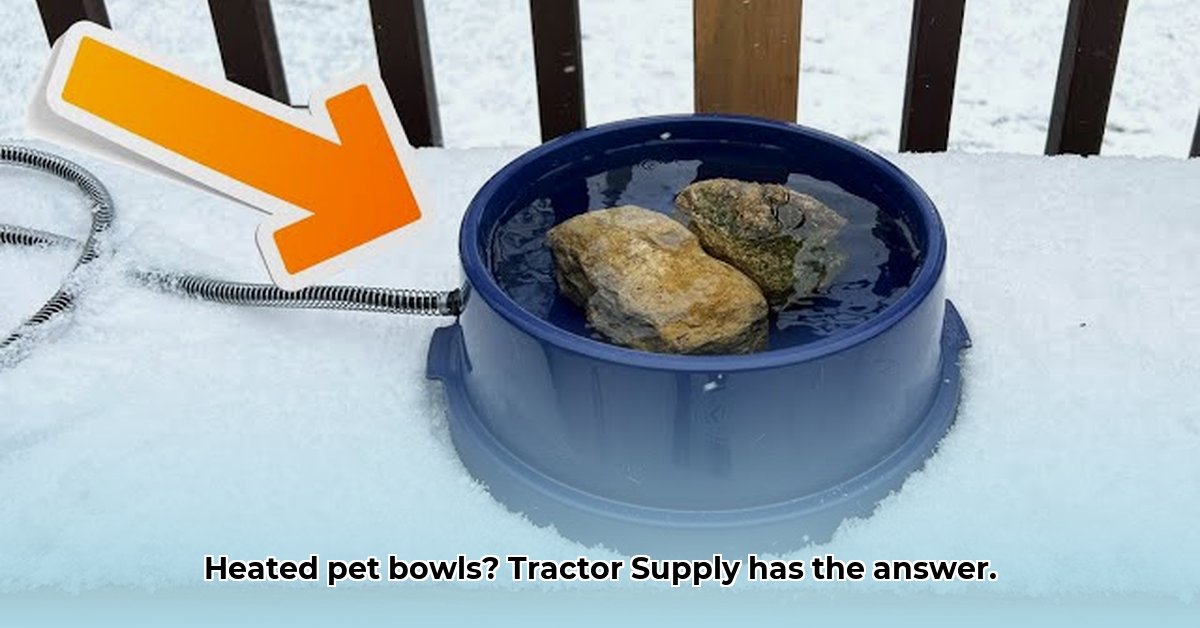
Heated Pet Bowl Tractor Supply: Your Guide to a Happy, Warm Mealtime
Choosing the right heated pet bowl can significantly improve your pet's mealtime experience, especially during colder months. This guide helps you navigate the options at Tractor Supply, ensuring you select a bowl that's safe, effective, and perfectly suited to your furry friend's needs. We'll cover essential features, compare hypothetical models, and provide crucial tips for safe use and cleaning. For additional pet supplies, check out our chick starter kit.
Understanding Your Pet's Unique Needs
Before selecting a heated pet bowl, consider your pet's individual characteristics. Does your pet gobble their food quickly or savor each bite? Slow eaters might benefit greatly from a heated bowl that keeps their food warm. What about your pet's health? Senior pets or those with arthritis may find it easier to eat from a conveniently positioned bowl. These factors are key to selecting a bowl that enhances, not hinders, their dining experience.
Key Features of a Quality Heated Pet Bowl
Several vital features distinguish a good heated pet bowl from a great one. Let's explore the most important factors:
Temperature Control: Adjustable temperature settings are paramount. The goal is a comfortably warm meal, not scalding food. Look for models with clear temperature indicators and a range of settings to prevent burns and encourage consumption.
Durable Materials: Stainless steel is a popular choice for its durability and easy cleaning. It resists scratches and damage better than other materials. Ceramic bowls offer an aesthetically pleasing option but are more prone to chipping. Always confirm dishwasher-safety for convenient cleaning.
Appropriate Size: Select a bowl size appropriate for your pet's breed and eating habits. A small dog doesn't need a large bowl, and vice-versa. Consider purchasing a larger capacity bowl if your pet eats multiple meals daily.
Safety Features: Most heated bowls are electric, requiring a nearby outlet. Prioritize safety features like automatic shut-off mechanisms to prevent overheating and hazards. Non-slip bases prevent tipping and spills.
Hypothetical Heated Pet Bowl Models (Tractor Supply)
To illustrate the range of available options, let's examine some hypothetical models from Tractor Supply:
| Model Name | Key Features | Pros | Cons |
|---|---|---|---|
| Cozy Critter Bowl | Adjustable temp, stainless steel, large capacity | Durable, easy cleaning, keeps food warm longer, user-friendly. | Higher price, requires an electrical outlet. |
| Warm & Fuzzy Feeder | Low-temp setting, non-slip base, smaller size | Safe for sensitive pets, prevents spills, easy cleaning, compact. | Smaller capacity; may not suit large or multiple pets. |
| Happy Hound Heater Bowl | Multiple temp settings, ceramic, automatic shutoff | Even heat distribution, attractive design, added safety. | Ceramic can chip; usually higher price than stainless steel. |
Choosing the Perfect Bowl: A Personalized Approach
Selecting the perfect bowl is about personalization. Consider your pet's age, breed, and health. A senior dog with arthritis needs a different bowl than a playful puppy. A warm meal enhances your pet's quality of life, but safety and hygiene are paramount.
Setting Up Your New Heated Pet Bowl: A Step-by-Step Guide
Read the Instructions: Before use, thoroughly review the manufacturer's instructions for safe operation.
Check the Temperature: After plugging in, allow the bowl to warm up and use a thermometer to verify the food temperature. It should be comfortably warm, not hot.
Safe Placement: Place the bowl in a stable, safe location with easy access to an outlet, keeping the cord out of your pet's reach. A non-slip base is highly recommended.
Supervise Your Pet: Always supervise your pet while they eat from the heated bowl to ensure their safety and observe their eating habits.
Maintaining Hygiene: Cleaning Your Heated Bowl
Regular cleaning is essential to prevent bacterial growth. Many bowls are dishwasher-safe, but always refer to the manufacturer's instructions. If hand-washing is necessary, use warm soapy water and a soft sponge. Wipe the exterior regularly with a damp cloth. Proper cleaning ensures a healthy and safe eating environment for your furry companion.